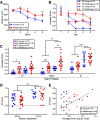Hippocampal Subregion Transcriptomic Profiles Reflect Strategy Selection during Cognitive Aging
- PMID: 32376783
- PMCID: PMC7326352
- DOI: 10.1523/JNEUROSCI.2944-19.2020
Hippocampal Subregion Transcriptomic Profiles Reflect Strategy Selection during Cognitive Aging
Abstract
Age-related cognitive impairments are associated with differentially expressed genes (DEGs) linked to defined neural systems; however, studies examining multiple regions of the hippocampus fail to find links between behavior and transcription in the dentate gyrus (DG). We hypothesized that use of a task requiring intact DG function would emphasize molecular signals in the DG associated with a decline in performance. We used a water maze beacon discrimination task to characterize young and middle-age male F344 rats, followed by a spatial reference memory probe trial test. Middle-age rats showed increased variability in discriminating two identical beacons. Use of an allocentric strategy and formation of a spatial reference memory were not different between age groups; however, older animals compensated for impaired beacon discrimination through greater reliance on spatial reference memory. mRNA sequencing of hippocampal subregions indicated DEGs in the DG of middle-age rats, linked to synaptic function and neurogenesis, correlated with beacon discrimination performance, suggesting that senescence of the DG underlies the impairment. Few genes correlated with spatial memory across age groups, with a greater number in region CA1. Age-related CA1 DEGs, correlated with spatial memory, were linked to regulation of neural activity. These results indicate that the beacon task is sensitive to impairment in middle age, and distinct gene profiles are observed in neural circuits that underlie beacon discrimination performance and allocentric memory. The use of different strategies in older animals and associated transcriptional profiles could provide an animal model for examining cognitive reserve and neural compensation of aging.SIGNIFICANCE STATEMENT Hippocampal subregions are thought to differentially contribute to memory. We took advantage of age-related variability in performance on a water maze beacon task and next-generation sequencing to test the hypothesis that aging of the dentate gyrus is linked to impaired beacon discrimination and compensatory use of allocentric memory. The dentate gyrus expressed synaptic function and neurogenesis genes correlated with beacon discrimination in middle-age animals. Spatial reference memory was associated with CA1 transcriptional correlates linked to regulation of neural activity and use of an allocentric strategy. This is the first study examining transcriptomes of multiple hippocampal subregions to link age-related impairments associated with discrimination of feature overlap and alternate response strategies to gene expression in specific hippocampal subregions.
Keywords: aging; hippocampus; pattern separation; reference memory; spatial discrimination; transcription.
Copyright © 2020 the authors.
Figures







Similar articles
-
Hippocampal subregions exhibit both distinct and shared transcriptomic responses to aging and nonneurodegenerative cognitive decline.J Gerontol A Biol Sci Med Sci. 2014 Nov;69(11):1311-24. doi: 10.1093/gerona/glu091. Epub 2014 Jul 2. J Gerontol A Biol Sci Med Sci. 2014. PMID: 24994846 Free PMC article.
-
Dentate spikes and learning: disrupting hippocampal function during memory consolidation can improve pattern separation.J Neurophysiol. 2019 Jan 1;121(1):131-139. doi: 10.1152/jn.00696.2018. Epub 2018 Nov 21. J Neurophysiol. 2019. PMID: 30461365
-
Concurrent hippocampal induction of MHC II pathway components and glial activation with advanced aging is not correlated with cognitive impairment.J Neuroinflammation. 2011 Oct 11;8:138. doi: 10.1186/1742-2094-8-138. J Neuroinflammation. 2011. PMID: 21989322 Free PMC article.
-
A behavioral assessment of hippocampal function based on a subregional analysis.Rev Neurosci. 2004;15(5):333-51. doi: 10.1515/revneuro.2004.15.5.333. Rev Neurosci. 2004. PMID: 15575490 Review.
-
An analysis of dentate gyrus function (an update).Behav Brain Res. 2018 Nov 15;354:84-91. doi: 10.1016/j.bbr.2017.07.033. Epub 2017 Jul 26. Behav Brain Res. 2018. PMID: 28756212 Review.
Cited by
-
Failure of senolytic treatment to prevent cognitive decline in a female rodent model of aging.Front Aging Neurosci. 2024 May 15;16:1384554. doi: 10.3389/fnagi.2024.1384554. eCollection 2024. Front Aging Neurosci. 2024. PMID: 38813533 Free PMC article.
-
Sex, senescence, senolytics, and cognition.Front Aging Neurosci. 2025 Mar 4;17:1555872. doi: 10.3389/fnagi.2025.1555872. eCollection 2025. Front Aging Neurosci. 2025. PMID: 40103928 Free PMC article. Review.
-
Age-Dependent Regulation of Hippocampal Inflammation by the Mitochondrial Translocator Protein in Mice.Aging Cell. 2025 Jun;24(6):e70039. doi: 10.1111/acel.70039. Epub 2025 Apr 24. Aging Cell. 2025. PMID: 40275629 Free PMC article.
-
Posterior cingulate cortex reveals an expression profile of resilience in cognitively intact elders.Brain Commun. 2022 Jun 21;4(4):fcac162. doi: 10.1093/braincomms/fcac162. eCollection 2022. Brain Commun. 2022. PMID: 35813880 Free PMC article.
-
Senolytic treatment alleviates doxorubicin-induced chemobrain.Aging Cell. 2024 Feb;23(2):e14037. doi: 10.1111/acel.14037. Epub 2024 Jan 15. Aging Cell. 2024. PMID: 38225896 Free PMC article.
References
Publication types
MeSH terms
Grants and funding
LinkOut - more resources
Full Text Sources
Molecular Biology Databases
Miscellaneous
